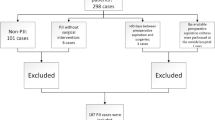Abstract
Purpose
Percutaneous synovial biopsy has recently been reported to have a high diagnostic value in the preoperative identification of periprosthetic infection of the hip. We report our experience with this technique in the evaluation of patients undergoing revision hip arthroplasty, comparing results of preoperative synovial biopsy with joint aspiration in identifying an infected hip arthroplasty by bacteriological analysis.
Materials and methods
We retrospectively reviewed the results of the 110 most recent revision hip arthroplasties in which preoperative synovial biopsy and joint aspiration were both performed. Revision surgery for these patients occurred during the period from September 2005 to March 2012. Using this study group, results from preoperative cultures were compared with preoperative laboratory studies and the results of intraoperative cultures. Synovial aspiration was done using an 18- or 20-gauge spinal needle. Synovial biopsy was done coaxially following aspiration using a 22-gauge Chiba needle or 21-gauge Sure-Cut needle. Standard microbiological analysis was performed on preoperative synovial fluid aspirate and synovial biopsy. Intraoperative tissue biopsy bacteriological analysis results at surgical revision were accepted as the “gold standard” for the presence or absence of infection.
Results
Seventeen of 110 (15 %) of patients had intraoperative culture-positive periprosthetic infection. Of these 17 cases, there were ten cases where either the synovial fluid aspiration and/or the synovial biopsy were true positive (sensitivity of 59 %, specificity of 100 %, positive predictive value of 100 % and accuracy of 94 %). There were seven cases where aspiration and biopsy results were both falsely negative, but no false-positive results. Similar results were found for synovial fluid aspiration alone. The results of synovial biopsy alone resulted in the identification of seven infected joints with no false-positive result (sensitivity of 41 %, specificity of 100 %, positive predictive value of 100 %, and accuracy of 91 %).
Conclusions
Standard microbiological analyses performed on percutaneous synovial biopsy specimen during the preoperative evaluation of patients undergoing revision hip arthroplasty did not improve detection of culture-positive periprosthetic infection as compared to synovial fluid aspiration alone.
Similar content being viewed by others
References
Kurtz SM, Ong KL, Lau E, Bozic KJ, Berry D, Parvizi J. Prosthetic joint infection risk after TKA in the Medicare population. Clin Orthop Relat Res. 2010;468(1):52–6.
Ong KL, Kurtz SM, Lau E, Bozic KJ, Berry DJ, Parvizi J. Prosthetic joint infection risk after total hip arthroplasty in the Medicare population. J Arthroplasty. 2009;24(6 Suppl):105–9.
Bozic KJ, Kurtz SM, Lau E, Ong K, Vail TP, Berry DJ. The epidemiology of revision total hip arthroplasty in the United States. J Bone Joint Surg Am. 2009;91(1):128–33.
Della Valle C, Parvizi J, Bauer TW, Dicesare PE, Evans RP, Segreti J, et al. Diagnosis of periprosthetic joint infections of the hip and knee. J Am Acad Orthop Surg. 2010;18(12):760–70.
Fink B, Gebhard A, Fuerst M, Berger I, Schafer P. High diagnostic value of synovial biopsy in periprosthetic joint Infection of the hip. Clin Orthop Relat Res. 2012;471(3):956–64.
Fink B, Makowiak C, Fuerst M, Berger I, Schafer P, Frommelt L. The value of synovial biopsy, joint aspiration and C-reactive protein in the diagnosis of late peri-prosthetic infection of total knee replacements. J Bone Joint Surg Br. 2008;90(7):874–8.
Pezzullo JC. Exact binomial and Poisson confidence intervals. http://statpages.org/confint.html.
Bauer TW, Parvizi J, Kobayashi N, Krebs V. Diagnosis of periprosthetic infection. J Bone Joint Surg Am. 2006;88(4):869–82.
Parvizi J, Jacovides C, Zmistowski B, Jung KA. Definition of periprosthetic joint infection: is there a consensus? Clin Orthop Relat Res. 2011;469(11):3022–30.
Schinsky MF, Della Valle CJ, Sporer SM, Paprosky WG. Perioperative testing for joint infection in patients undergoing revision total hip arthroplasty. J Bone Joint Surg Am. 2008;90(9):1869–75.
Spangehl MJ, Masri BA, O’Connell JX, Duncan CP. Prospective analysis of preoperative and intraoperative investigations for the diagnosis of infection at the sites of two hundred and two revision total hip arthroplasties. J Bone Joint Surg Am. 1999;81(5):672–83.
Trampuz A, Piper KE, Jacobson MJ, Hanssen AD, Unni KK, Osmon DR, et al. Sonication of removed hip and knee prostheses for diagnosis of infection. N Engl J Med. 2007;357(7):654–63.
Conflict of interest
The authors declare that they have no conflicts of interest.
Author information
Authors and Affiliations
Corresponding author
Rights and permissions
About this article
Cite this article
Cross, M.C., Kransdorf, M.J., Chivers, F.S. et al. Utility of percutaneous joint aspiration and synovial biopsy in identifying culture-positive infected hip arthroplasty. Skeletal Radiol 43, 165–168 (2014). https://doi.org/10.1007/s00256-013-1757-6
Received:
Revised:
Accepted:
Published:
Issue Date:
DOI: https://doi.org/10.1007/s00256-013-1757-6




